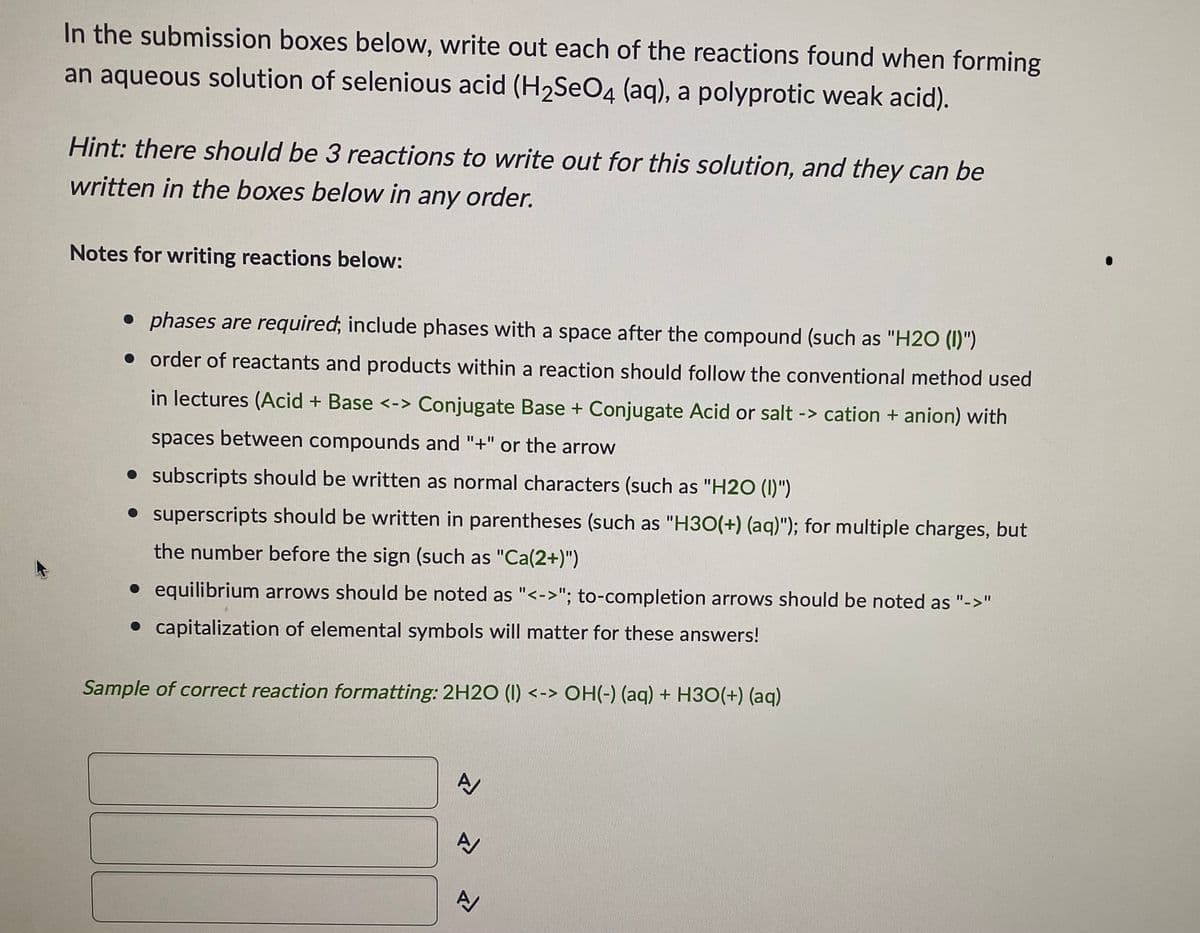In the submission boxes below, write out each of the reactions found when forming an aqueous solution of selenious acid (H₂SeO4 (aq), a polyprotic weak acid). Hint: there should be 3 reactions to write out for this solution, and they can be written in the boxes below in any order. Notes for writing reactions below: • phases are required, include phases with a space after the compound (such as "H20 (1)") order of reactants and products within a reaction should follow the conventional method used in lectures (Acid + Base <-> Conjugate Base + Conjugate Acid or salt -> cation + anion) with spaces between compounds and "+" or the arrow • subscripts should be written as normal characters (such as "H20 (1)") • superscripts should be written in parentheses (such as "H3O(+) (aq)"); for multiple charges, but the number before the sign (such as "Ca(2+)") equilibrium arrows should be noted as "<->"; to-completion arrows should be noted as "->" capitalization of elemental symbols will matter for these answers! Sample of correct reaction formatting: 2H2O (I) <-> OH(-) (aq) + H30(+) (aq)
In the submission boxes below, write out each of the reactions found when forming an aqueous solution of selenious acid (H₂SeO4 (aq), a polyprotic weak acid). Hint: there should be 3 reactions to write out for this solution, and they can be written in the boxes below in any order. Notes for writing reactions below: • phases are required, include phases with a space after the compound (such as "H20 (1)") order of reactants and products within a reaction should follow the conventional method used in lectures (Acid + Base <-> Conjugate Base + Conjugate Acid or salt -> cation + anion) with spaces between compounds and "+" or the arrow • subscripts should be written as normal characters (such as "H20 (1)") • superscripts should be written in parentheses (such as "H3O(+) (aq)"); for multiple charges, but the number before the sign (such as "Ca(2+)") equilibrium arrows should be noted as "<->"; to-completion arrows should be noted as "->" capitalization of elemental symbols will matter for these answers! Sample of correct reaction formatting: 2H2O (I) <-> OH(-) (aq) + H30(+) (aq)
Chemistry
10th Edition
ISBN:9781305957404
Author:Steven S. Zumdahl, Susan A. Zumdahl, Donald J. DeCoste
Publisher:Steven S. Zumdahl, Susan A. Zumdahl, Donald J. DeCoste
Chapter1: Chemical Foundations
Section: Chapter Questions
Problem 1RQ: Define and explain the differences between the following terms. a. law and theory b. theory and...
Related questions
Question
Urgent please

Transcribed Image Text:In the submission boxes below, write out each of the reactions found when forming
an aqueous solution of selenious acid (H₂SO4 (aq), a polyprotic weak acid).
Hint: there should be 3 reactions to write out for this solution, and they can be
written in the boxes below in any order.
Notes for writing reactions below:
• phases are required; include phases with a space after the compound (such as "H2O (I)")
• order of reactants and products within a reaction should follow the conventional method used
in lectures (Acid + Base <-> Conjugate Base + Conjugate Acid or salt -> cation + anion) with
spaces between compounds and "+" or the arrow
• subscripts should be written as normal characters (such as "H2O (1)")
superscripts should be written in parentheses (such as "H30(+) (aq)"); for multiple charges, but
the number before the sign (such as "Ca(2+)")
• equilibrium arrows should be noted as "<->"; to-completion arrows should be noted as "->"
• capitalization of elemental symbols will matter for these answers!
Sample of correct reaction formatting: 2H2O (I) <-> OH(-) (aq) + H3O(+) (aq)
N
Expert Solution
This question has been solved!
Explore an expertly crafted, step-by-step solution for a thorough understanding of key concepts.
Step by step
Solved in 2 steps

Knowledge Booster
Learn more about
Need a deep-dive on the concept behind this application? Look no further. Learn more about this topic, chemistry and related others by exploring similar questions and additional content below.Recommended textbooks for you

Chemistry
Chemistry
ISBN:
9781305957404
Author:
Steven S. Zumdahl, Susan A. Zumdahl, Donald J. DeCoste
Publisher:
Cengage Learning

Chemistry
Chemistry
ISBN:
9781259911156
Author:
Raymond Chang Dr., Jason Overby Professor
Publisher:
McGraw-Hill Education

Principles of Instrumental Analysis
Chemistry
ISBN:
9781305577213
Author:
Douglas A. Skoog, F. James Holler, Stanley R. Crouch
Publisher:
Cengage Learning

Chemistry
Chemistry
ISBN:
9781305957404
Author:
Steven S. Zumdahl, Susan A. Zumdahl, Donald J. DeCoste
Publisher:
Cengage Learning

Chemistry
Chemistry
ISBN:
9781259911156
Author:
Raymond Chang Dr., Jason Overby Professor
Publisher:
McGraw-Hill Education

Principles of Instrumental Analysis
Chemistry
ISBN:
9781305577213
Author:
Douglas A. Skoog, F. James Holler, Stanley R. Crouch
Publisher:
Cengage Learning

Organic Chemistry
Chemistry
ISBN:
9780078021558
Author:
Janice Gorzynski Smith Dr.
Publisher:
McGraw-Hill Education

Chemistry: Principles and Reactions
Chemistry
ISBN:
9781305079373
Author:
William L. Masterton, Cecile N. Hurley
Publisher:
Cengage Learning

Elementary Principles of Chemical Processes, Bind…
Chemistry
ISBN:
9781118431221
Author:
Richard M. Felder, Ronald W. Rousseau, Lisa G. Bullard
Publisher:
WILEY